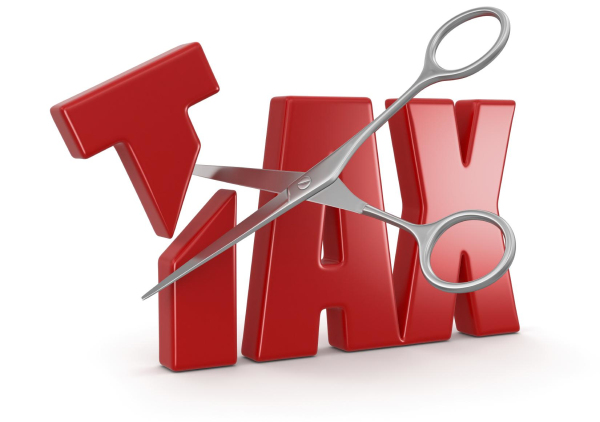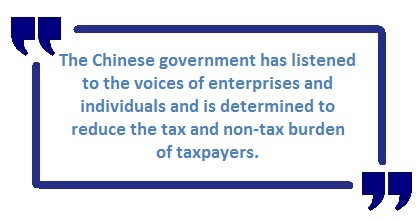Interpretation of key fiscal and taxation tasks in 2017 delivered in recent National People's Congress
By Kelvin Lee, PwC Tianjin
 In brief
In brief
The past year, 2016, was the first year of the 13th Five-Year Plan, with remarkable achievements in fiscal and taxation reform in China (the Reform). 2017 will be the year of deepening such Reform. What initiatives will be pushed forward by the Chinese Government? The answers were delivered at the Fifth Session of the 12th National People's Congress (NPC) on 5th March 2017 (the Session). During the Session, Premier Li Keqiang spoke on the government work report for the New Year (the Work Report)1, which reviewed the accomplishments made in 2016 and deployed the key tasks for 2017. The major fiscal and taxation tasks include simplifying the Value Added Tax (VAT) rate categories, increasing percentage of Research and Development (R&D) expenses, super deduction for Corporate Income Tax (CIT) purpose for small and medium-sized technological enterprises, relaxing the threshold for qualified small and thin-profit enterprises to enjoy CIT preferential treatments and further standardising and eliminating the non-tax burden of the enterprises. Following that, the Minister of the Ministry of Finance (MOF), Mr. Xiao Jie shared his views in the MOF press conference held on 7th March 20172 in respect of a series of hot topics regarding the reform, including status of the Individual Income Tax (IIT) reform as well as extension of the valid period of certain tax incentives.
In detail
Simplifying the current VAT rate categories
 After the comprehensive roll-out of transformation of Business Tax to VAT (the B2V Reform) since 1st May 2016, except for certain zero-rated taxable activities, there are four VAT rate categories, namely the rate for sales/import of general goods, provision of processing, repairing or replacement services and tangible movable properties leasing services is 17%; the rate for sales/import of specific goods (e.g. agricultural products, natural gas, books etc.) is 13%; the rate for transportation services, postal services, basic telecommunication services, construction services, immovable property leasing services and sales of land use right or immovable properties is 11% and the rate for other taxable activities (such as financial services and consumer services, etc.) is 6%. Setting of these different VAT rate categories has fully taken into consideration the differences among various taxable activities. However it has resulted in more compliance burden for taxpayers and brought more challenges to the tax collection and administration by tax authorities. To solve this issue, the Work Report indicates that the current four VAT categories will be simplified to three so as to build a concise, transparent and fairer taxation environment.
After the comprehensive roll-out of transformation of Business Tax to VAT (the B2V Reform) since 1st May 2016, except for certain zero-rated taxable activities, there are four VAT rate categories, namely the rate for sales/import of general goods, provision of processing, repairing or replacement services and tangible movable properties leasing services is 17%; the rate for sales/import of specific goods (e.g. agricultural products, natural gas, books etc.) is 13%; the rate for transportation services, postal services, basic telecommunication services, construction services, immovable property leasing services and sales of land use right or immovable properties is 11% and the rate for other taxable activities (such as financial services and consumer services, etc.) is 6%. Setting of these different VAT rate categories has fully taken into consideration the differences among various taxable activities. However it has resulted in more compliance burden for taxpayers and brought more challenges to the tax collection and administration by tax authorities. To solve this issue, the Work Report indicates that the current four VAT categories will be simplified to three so as to build a concise, transparent and fairer taxation environment.
The detailed regulation to implement the above initiatives has not yet been released. However, with the backdrop of further reducing enterprises' tax burdens and increasing demand for lowering the VAT rates, if a higher VAT rate category can be moved to or combined with a lower rate category, it would undoubtedly be welcomed by taxpayers.
Besides, after the comprehensive roll-out of the B2V Reform, a series of follow-up circulars have been released to clarify the relevant industry issues under this reform. We noticed that the Work Report also addresses the need to further implement and improve the B2V policies. We believe that the MOF together with State Administration of Taxation (SAT) will continue to release industry specific circulars to respond to taxpayers' concerns and improve policies to ensure a smooth implementation of the B2V Reform.
Structural tax reduction to support small and medium-sized technological enterprises and small and thin-profit enterprises
 In recent years, China has pushed forward a series of tax incentives to implement her innovation-driven strategy. As small and medium-sized technological enterprises have become a major driving force to boost innovation, supporting development of these enterprises is also one of the important contents in the 13th Five-Year Plan. The Work Report proposes to increase the percentage of R&D expenses super deduction for CIT purpose for small and medium-sized technological enterprises from 50% to 75%, which notably increases the level of supporting these enterprises and will play an active role in stimulating their innovation vitality. This favourable initiative together with the current tax regime for New/High Technology Enterprises makes R&D motivated tax policies in China more integrated and focussed.
In recent years, China has pushed forward a series of tax incentives to implement her innovation-driven strategy. As small and medium-sized technological enterprises have become a major driving force to boost innovation, supporting development of these enterprises is also one of the important contents in the 13th Five-Year Plan. The Work Report proposes to increase the percentage of R&D expenses super deduction for CIT purpose for small and medium-sized technological enterprises from 50% to 75%, which notably increases the level of supporting these enterprises and will play an active role in stimulating their innovation vitality. This favourable initiative together with the current tax regime for New/High Technology Enterprises makes R&D motivated tax policies in China more integrated and focussed.
Meanwhile, the Work Report also sets a lower threshold for small and thin-profit enterprises to enjoy CIT preferential treatments. According to prevailing tax incentives, small and thin-profit enterprise whose annual taxable income does not exceed RMB 300,000 would be subject to CIT at the rate of 20% on 50% of its annual taxable income. The Work Report relaxes the threshold from an annual taxable income of not more than RMB 300,000 to not more than RMB 500,000, which will benefit more small and thin-profit enterprises.
It is not difficult to see that China is paying more and more attention to small and medium-sized enterprises in order to support start-up and innovation, especially technological enterprises which play a pivotal part in optimising and upgrading China's industrial structure. The tax preferential initiative proposed in the Work Report will foster growth of small and medium-sized enterprises by further encouraging their R&D investments and reducing their tax burden. It is worth noting that the threshold of annual taxable income of RMB 300,000 for small and thin-profit enterprises and the 50% R&D expenses super deduction are stipulated in the Detailed Implementation Rules (DIR) of the CIT Law. In this regard, attention should be paid on how such proposed tax initiatives in the Work Report would interact with the relevant provisions in the DIR of the CIT Law.
Further alleviating enterprises' burden
 Recently, whether the tax burden of Chinese enterprises is heavy is a hot topic for discussion in China. In fact, in addition to paying taxes, enterprises also pay numerous fees and charges to the Chinese government, which are almost as heavy as the tax burden.
Recently, whether the tax burden of Chinese enterprises is heavy is a hot topic for discussion in China. In fact, in addition to paying taxes, enterprises also pay numerous fees and charges to the Chinese government, which are almost as heavy as the tax burden.
During recent years, while focusing on reducing the tax burden of enterprises, the Chinese government is also dedicated to eliminating fees that are non-compliance and unreasonable. For example, the State Council issued the Work Scheme of Promoting the Reform of Streamlining Administration, Delegating Powers and Combining Administration with Decentralization to Transform Government Functions in 2015, with the aim to clean up and standardise fees, funds, mandatory monopolistic operational service fees and charges by industry associations, etc.
This trend will continue in 2017. From the perspective of fiscal budget, the Work Report proposes to further reduce the tax burden and non-tax charges by around RMB 350 billion and RMB 200 billion respectively for the year 2017. In terms of practical measures, government funds, administrative charges, as well as illegal charges for administrative approved intermediaries, services will be further cleaned up and standardised. Furthermore, the Work Report also proposes to reduce operational government fee charges to enterprises, appropriately lower the enterprises' proportion in relation to social security and housing fund and reduce institutional transaction costs.
Clarifying the direction of IIT reform and extending the valid period of tax incentives
 In addition to addressing various initiatives to reduce taxes and fees in the Work Report, Minister Xiao also disclosed certain tax-related work plan in the subsequent MOF press conference.
In addition to addressing various initiatives to reduce taxes and fees in the Work Report, Minister Xiao also disclosed certain tax-related work plan in the subsequent MOF press conference.
Regarding the IIT reform which the general public is concerned with, Minister Xiao clarified that an IIT reform scheme comprising of a combination of comprehensive and category taxation which is suitable for China will be implemented. Basically, certain categories of income, such as wages and salaries, labour remuneration and authors' contribution remuneration, etc. will be combined into a comprehensive category with an annual IIT filing, while other categories of income such as those derived from transfer of property, etc. may remain subject to IIT on a per-category basis. Meanwhile, as a brand new initiative, certain items such as expenses to support family livelihood etc. may be allowed to be deducted in computing taxable income. Moreover, regarding the IIT exemption amount which is under the spotlight for a long time, Minister Xiao responded that household consumption level and other factors would be taken into account when determining whether the current standard IIT exemption amount needs to be increased. To better support the IIT reform, Minister Xiao also emphasised the importance of tax collection and administration with which the tax authorities could grasp tax-related information with regard to taxpayers' income and ensure smooth implementation of the IIT reform.
Minister Xiao also mentioned that six tax preferential policies which have already expired at the end of 2016 will continue to be granted to eligible taxpayers in 2017. One of these policies is the tax incentive to support the start-up and employment of focus groups while the remaining five were not clarified by Minister Xiao. Let's stay tuned for the coming detailed implementation measures.
The takeaway
 In the past few years, the Chinese government has been working on the transformation of tax regime and reduction of tax burden to taxpayers. The initiatives taken by the Chinese government include the B2V Reform, Resource Tax reform and the enactment of Environmental Protection Tax Law, etc., all of which contribute to the structural tax reduction by cleaning up fees and replacing them with taxes. The B2V Reform alone has resulted in reduction of tax burden at the national level of over RMB 570 billion in 2016.
In the past few years, the Chinese government has been working on the transformation of tax regime and reduction of tax burden to taxpayers. The initiatives taken by the Chinese government include the B2V Reform, Resource Tax reform and the enactment of Environmental Protection Tax Law, etc., all of which contribute to the structural tax reduction by cleaning up fees and replacing them with taxes. The B2V Reform alone has resulted in reduction of tax burden at the national level of over RMB 570 billion in 2016.
However, the Chinese government is not content just with excellent achievements collected in the data, but is really concerned with the real needs of enterprises and individuals and will ensure that reduction in tax burden would actually go to them. In early 2017, Premier Li stated at a forum that the government wants enterprises to experience the reduction of non-tax burden through lowering of fees. President Xi Jinping also emphasised at the recent Leading Group Conference for Financial and Economic Affairs that the government should make every effort to reduce the burden of enterprises.
Messages delivered in the Work Report regarding reducing taxes and fees to push forward the tax reform and the MOF press conference show that the Chinese government has listened to the voices of enterprises and individuals and is determined to reduce the tax and non-tax burden of taxpayers. We will pay close attention to the issuance of relevant implementation regulations and share our observation and interpretation from time to time.
---END---